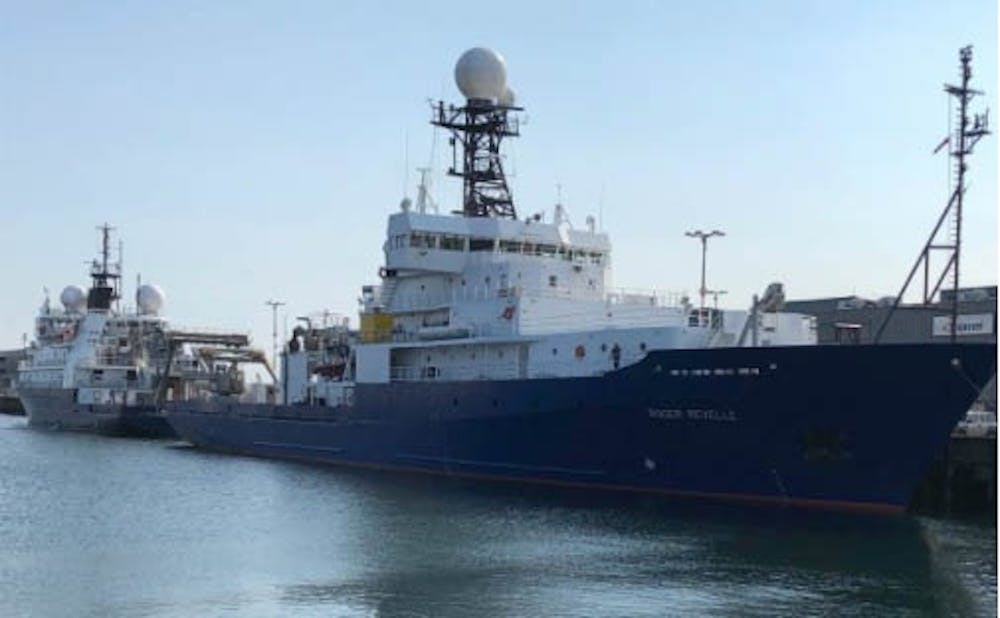This past summer, Alexandria Niebergall and Weiyi Tang—Ph.D. students in the Nicholas School of the Environment—took part in a research cruise in the Northern Pacific Ocean. The two worked together as part of the Export Processes in the Ocean from Remote Sensing (EXPORTS) project, a NASA-funded campaign focused on the fate of global ocean net primary production and its implications for present and future climates.
Their research on the cruise involved looking at the role of marine microbes in the surface ocean drawing carbon dioxide out of the atmosphere. Tang and Niebergall answered some questions about their project in an interview with The Chronicle. This interview has been edited for length and clarity.
The Chronicle: What was your favorite part about the project?
Alexandria Niebergall: My favorite part of the project was getting to work with so many other amazing scientists from NASA and other universities across the United States. It was very exciting to see what everyone was working on and how our projects fit together to answer our large questions about the biological carbon pump and the role that the oceans play in moderating the Earth’s climate.
Weiyi Tang: I have similar feelings to Alex. Numerous scientists and students from different universities and institutes are involved in the EXPORTS projects. Communicating and working with them was exciting and pleasant.
TC: How has this research contributed to your own understanding of climate change?
AN: This research has given me a greater appreciation for the intricacies and the fine balance of the Earth’s climate system. Our project is studying the biological carbon pump—a system that draws carbon dioxide out of the atmosphere through photosynthesis, and eventually sequesters it in the deep ocean over long geologic time scales. This system is influenced by a multitude of biogeochemical factors including nutrient and light availability, nitrogen fixation, microbial community composition, and ocean currents to name a few. Studying the biological carbon pump hands-on has given me a broad appreciation for these intricate details and the challenges surrounding studying them in the field.
WT: This research gave me a better idea of how to observe and understand the role of ocean in climate change from different perspectives. As Alex described, the effects of marine production and biological carbon pump on the atmospheric carbon dioxide concentration, the distribution and magnitude of biological carbon pump can be tightly related to the climate change. Collective research projects like EXPORTS apply multiple approaches to observe the marine carbon cycle at various spatial and temporal scales. These efforts will help to capture and resolve the responses of marine ecosystems to climate change and the feedback among these processes, leading to a better understanding of the Earth’s climate.
TC: What was a day in the life like for you on the cruise?
AN: For the most part, I had a pretty consistent schedule on the ship. We had instruments running 24/7 so we always had someone in the lab keeping an eye on things. On a typical day, my shift started at 3 a.m. Our first sampling station for the day usually started at about 6:30 a.m. This first station was very busy because we had a lot of groups who were trying to get water to start their tests that day.
After breakfast, I would filter the water samples I collected and flash freeze them in liquid nitrogen for DNA sequencing here at Duke. After lunch, I usually had some free time to catch up on sleep or go to the gym on the ship. In the evenings, my colleague, Weiyi Tang, would sample 20-plus bottles from the calibration CTD cast and I would add reagent to the bottles to fix the dissolved oxygen in the water so that we could measure it later. If we had bad weather or other unforeseen circumstances, this schedule would change a little bit.
WT: My shift went from 11 a.m. to 3 a.m. on the next day. I spent most of the afternoon watching the instrument that measured oxygen and argon in the surface seawater continuously. The instrument is routinely examined, including cleaning and changing filters.
I also had some time reading and writing. But it was more difficult than being on land. Usually before dinner, Alex and I would collect seawater at different depths from a rosette equipped with Niskin bottles. After the sampling, we would watch the sunset if it was sunny. At night, I would analyze the oxygen concentrations from these seawater samples, which would then be used to calibrate the oxygen concentrations measured by autonomous platforms like floats and Seagliders.
Get The Chronicle straight to your inbox
Signup for our weekly newsletter. Cancel at any time.

